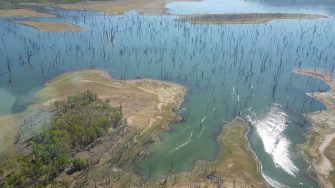
Date: Thursday, October 4, 2018
Project: Eastern Australian Waterbird Survey
Observers: Richard Kingsford
Great day to start flying today, with no wind. We can deal with the heat – 35oC west of the Great Divide – but a buffeting wind and heat bounce the aeroplane around, making it uncomfortable. We took off, leaving the vivid blue ocean and its islands to the east and headed west for Mt Isa.
Prosperine Dam was our first major survey point. It had some quite shallow areas and thousands of waterbirds usually, but it always depends on the season – wet not much, dry lots. As expected, there were thousands of waterbirds today, with high diversity. Hardhead and coot in particular formed large closely packed rafts across the water. But there were also pink-eared ducks, grey teal and swans. There was one very large flock of cormorants, numbering in the thousands.
Then over the hills to the Burdekin River catchment. With not much wind, it was great flying down the Bowen River. Along the way, there were lots more waterbirds than usual along the Bowen River. A couple of majestic black-necked storks or jabirus unfolded their large white wings with black stripes and languidly flew up. It was also a nice surprise to see about ten bustards.
When the Bowen River meets the Burdekin River, we headed south, upstream along the Burdekin River. This is a very pretty river with its bed strewn with large red boulders. It gets even more striking once we enter the gorge country with hills rising on either side. Not much in the way of waterbirds, just the odd large egret and darters. There were also quite a few straw-necked ibis, more than I have seen in the past.
Water was obviously being released for downstream irrigation as the river would not normally run at this time of the year. We eventually reached the dam wall and started surveying the main dam.
Flying up the Burdekin River to Burdekin Falls Dam.
Burdekin Falls Dam is a massive expanse of water (1,860,000 ML or over three Sydney Harbours worth water). Today it was below 80% full (https://www.sunwater.com.au/dams/burdekin-falls-dam). Even though there is water everywhere, the waterbirds are not. The dam is just too deep and unproductive.
Wide expanse of Burdekin Falls Dam
It gets a little more interesting when we get up to where the Burdekin River flows into the dam. Here there are more waterbirds, including black duck and wood duck but not in particularly high numbers. There was one spectacular flock of cormorants, packed in, feeding presumably.
Once we were done with Burdekin River, we headed west, bumping up and down over the odd farm dam, south of Charters Towers. Many of them were dry but one had a small flock of white pygmy geese, among the grey teal and black duck. One of the dry swamps had half a dozen camels. Wondered whether these were domesticated – otherwise wild camels seem much further east than I thought.
Hughenden for a lunch in the heat. Another bonus of this Caravan is the air conditioning. We are avoiding sweltering in heat that we used to have in the Cessna 206. After lunch, the flying wasn’t so smooth as the wind and heat combined. We stopped for a short break out in the middle of nowhere on an outback strip.
Here the rivers are of sand, contrasting the dry landscapes and there are only a few small patches of water between Hughenden and Mt Isa. All had waterbirds, clustering around whatever water was around. Most of the farm dams were dry but a few held water.
Last but not least, we surveyed Lake Moondarra, a dam which supplies Mt Isa. It was down in levels, perhaps only 60% full. I had expected it to be brimming with waterbirds, given how dry everywhere is but it probably had about five thousand, including rafts of hardhead and small flocks of glossy ibis.
